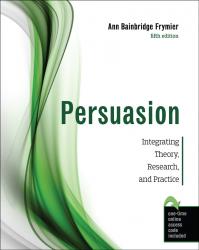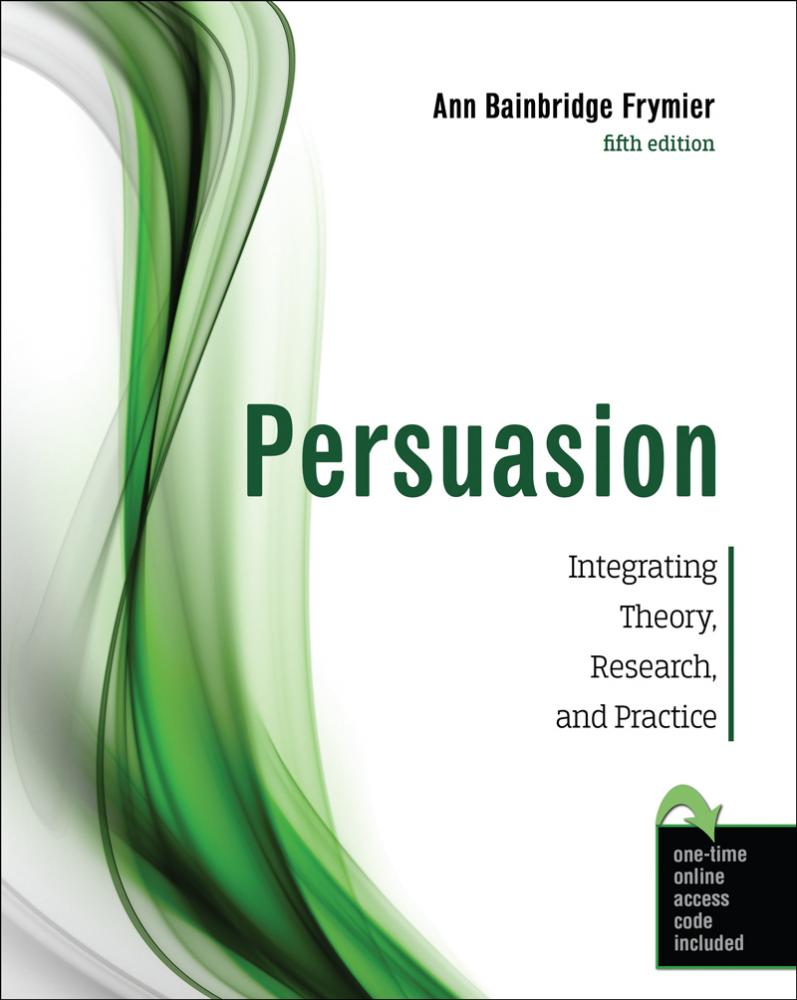Persuasion: Integrating Theory, Research, and Practice
Choose Your Format
Choose Your Platform | Help Me Choose
Students want to learn how to persuade parents, teachers, and classmates.
Teachers often view a skills approach as too limiting and focus on theories of persuasion.
Persuasion: Integrating Theory, Research, and Practice features an unprecedented fusion of the persuasion skills that students seek, integrated with persuasion theories instructors want to teach - the two approaches that have often been at odds with one another. It illustrates that practice and application serves as a means to understanding theory and, conversely, that theory serves as a means for understanding practice and application.
Ann Bainbridge Frymier’s Persuasion: Integrating Theory, Research, and Practice:
- explains major theories of persuasion using research to illustrate the development and application of each theory.
- features chapters on compliance, propaganda, deception, and ethics as they relate to persuasion.
- includes current examples throughout that bring the application of persuasion concepts to life.
- is interactive! Students are given access to an accompanying website with chapter outlines and quizzes.
- is easy to adopt! Instructors are provided course outlines, PowerPoint™ presentations, class activities, polling questions, video clip suggestions, and exam questions that can be integrated with most course management systems.
PREFACE
ABOUT THE AUTHOR
CHAPTER 1 THE CONCEPT OF PERSUASION
Learning Objectives
Defining Characteristics of Persuasion
Why Study Persuasion?
Where and When Do We Persuade?
Persuasion as One of Multiple Forms of Influence
The Role of Ethics in Persuasion
The Layout of The Book
Summary
Key Terms
Review Questions
Discussion Questions
References
CHAPTER 2 ATTITUDES AND BELIEFS
Learning Objectives
Characteristics of Attitudes
Beliefs and Behaviors
Theories of Attitude, Belief, and Behavior Formation
The Functions of Attitudes
How Do We Measure Attitudes and Beliefs?
Summary
Key Terms
Review Questions
Discussion Questions
References
CHAPTER 3 THE RELATIONSHIP BETWEEN ATTITUDES AND BEHAVIORS
Learning Objectives
Do Attitudes Influence Behavior?
Influencing Behavior
Summary
Key Terms
Review Questions
Discussion Questions
References
CHAPTER 4 SOURCE FACTORS
Learning Objectives
Credibility
Credibility and Persuasion
Power
Summary
Key Terms
Review Questions
Discussion Questions
References
CHAPTER 5 MESSAGE FACTORS
Learning Objectives
Emotional Appeals
Logical Appeals
Message Style
Summary
Key Terms
Review Questions
Discussion Questions
References
CHAPTER 6 RECEIVER AND CHANNEL FACTORS
Learning Objectives
Receiver Characteristics
Audience Segmentation and Targeted Messages
Channels
Summary
Key Terms
Review Questions
Discussion Questions
References
CHAPTER 7 THE ROLE OF THEORY IN PERSUASION
Learning Objectives
What Is a Theory?
Why Do We Need Theories?
Scientific versus Folk Theory
How Do We Test Theory?
Classic Theories of Persuasion
Unanswered Questions
Summary
Key Terms
Review Questions
Discussion Questions
References
CHAPTER 8 SOCIAL JUDGMENT THEORY
Learning Objectives
Latitudes of Acceptance and Rejection
Judgments and Attitude Change
Ego-Involvement
Changing Attitudes with Social Judgment Theory
Applying Social Judgment Theory
Strengths and Limitations
Summary
Key Terms
Review Questions
Discussion Questions
References
CHAPTER 9 CONSISTENCY AND COGNITIVE DISSONANCE THEORY
Learning Objectives
Consistency
Cognitive Dissonance Theory
Cognitive Dissonance Contexts
Necessary Conditions for Cognitive Dissonance
Applying Cognitive Dissonance Theory
Alternate Explanations
Strengths and Limitations
Summary
Key Terms
Review Questions
Discussion Questions
References
CHAPTER 10 A REASONED ACTION APPROACH
Learning Objectives
Attitudes are Not Alone
The Model
Strategies for Influence
Strengths and Limitations
Summary
Key Terms
Review Questions
Discussion Questions
References
CHAPTER 11 ELABORATION LIKELIHOOD MODEL
Learning Objectives
Two Routes to Attitude Change
Central versus Peripheral Routes
Testing ELM
Applying ELM to Influence Attitudes
Strengths and Limitations
Summary
Key Terms
Review Questions
Discussion Questions
References
CHAPTER 12 COMPLIANCE STRATEGIES
Learning Objectives
Levels of Influence
Compliance-Gaining Typologies
Sequential Request Strategies
Propaganda
Summary
Key Terms
Review Questions
Discussion Questions
References
CHAPTER 13 TRUTH AND DECEPTION
Learning Objectives
Deception as a Persuasive Tactic
Truth and Honesty
Deception and Credibility
Deception
Motives for Truthfulness and Deception
Lie Detection
Summary
Key Terms
Review Questions
Discussion Questions
References
CHAPTER 14 ETHICS
Learning Objectives
Ethical Nature of Persuasion
Rules-Based Approaches to Ethics
Johannesen’s Ethical Perspectives
The Big Questions
Summary
Key Terms
Review Questions
Discussion Questions
References
INDEX
Ann Bainbridge Frymier is a Professor of Communication and Associate Dean of the Graduate School at Miami University and received an Ed.D. in communication studies and curriculum and instruction in 1992 from West Virginia University.
Dr. Frymier’s primary area of research is instructional communication, focusing on effective communication in instructional environments. Her research is published in a variety of journals including Communication Education, Communication Quarterly, Journal of Applied Communication, and Communication Research Reports and has written several book chapters.
Dr. Frymier frequently teaches persuasion and research methods and has taught a wide variety of other courses, including instructional communication, interpersonal communication, organizational communication, intercultural communication, and nonverbal communication.
Persuasion: Integrating Theory, Research, and Practice is my first choice as a textbook for the introductory persuasion and social influence course. It is organized logically, written at just the right level, covers the most important persuasion concepts and theories, and includes recent and relevant examples. Best of all, my students consistently comment in my course evaluations that they actually read this book and enjoy it!
Jennifer Waldeck | Chapman University
Persuasion: Integrating Theory, Research and Practice is both comprehensive and accessible. Carefully organized, the text provides students with extensive coverage of theories, models and concepts along with engaging examples and exercises.
Anne F. Mattina | Stonehill College
Persuasion: Integrating Theory, Research and Practice is accessible to students and has a great combination of theory and integration.
Donna Allen | Northwest Nazarene University
Persuasion: Integrating Theory, Research and Practice is theory-driven but focused more on application instead of telling students all about the experiments that were conducted on the theory.
Laura R. Umphrey | Northern Arizona University
Students want to learn how to persuade parents, teachers, and classmates.
Teachers often view a skills approach as too limiting and focus on theories of persuasion.
Persuasion: Integrating Theory, Research, and Practice features an unprecedented fusion of the persuasion skills that students seek, integrated with persuasion theories instructors want to teach - the two approaches that have often been at odds with one another. It illustrates that practice and application serves as a means to understanding theory and, conversely, that theory serves as a means for understanding practice and application.
Ann Bainbridge Frymier’s Persuasion: Integrating Theory, Research, and Practice:
- explains major theories of persuasion using research to illustrate the development and application of each theory.
- features chapters on compliance, propaganda, deception, and ethics as they relate to persuasion.
- includes current examples throughout that bring the application of persuasion concepts to life.
- is interactive! Students are given access to an accompanying website with chapter outlines and quizzes.
- is easy to adopt! Instructors are provided course outlines, PowerPoint™ presentations, class activities, polling questions, video clip suggestions, and exam questions that can be integrated with most course management systems.
PREFACE
ABOUT THE AUTHOR
CHAPTER 1 THE CONCEPT OF PERSUASION
Learning Objectives
Defining Characteristics of Persuasion
Why Study Persuasion?
Where and When Do We Persuade?
Persuasion as One of Multiple Forms of Influence
The Role of Ethics in Persuasion
The Layout of The Book
Summary
Key Terms
Review Questions
Discussion Questions
References
CHAPTER 2 ATTITUDES AND BELIEFS
Learning Objectives
Characteristics of Attitudes
Beliefs and Behaviors
Theories of Attitude, Belief, and Behavior Formation
The Functions of Attitudes
How Do We Measure Attitudes and Beliefs?
Summary
Key Terms
Review Questions
Discussion Questions
References
CHAPTER 3 THE RELATIONSHIP BETWEEN ATTITUDES AND BEHAVIORS
Learning Objectives
Do Attitudes Influence Behavior?
Influencing Behavior
Summary
Key Terms
Review Questions
Discussion Questions
References
CHAPTER 4 SOURCE FACTORS
Learning Objectives
Credibility
Credibility and Persuasion
Power
Summary
Key Terms
Review Questions
Discussion Questions
References
CHAPTER 5 MESSAGE FACTORS
Learning Objectives
Emotional Appeals
Logical Appeals
Message Style
Summary
Key Terms
Review Questions
Discussion Questions
References
CHAPTER 6 RECEIVER AND CHANNEL FACTORS
Learning Objectives
Receiver Characteristics
Audience Segmentation and Targeted Messages
Channels
Summary
Key Terms
Review Questions
Discussion Questions
References
CHAPTER 7 THE ROLE OF THEORY IN PERSUASION
Learning Objectives
What Is a Theory?
Why Do We Need Theories?
Scientific versus Folk Theory
How Do We Test Theory?
Classic Theories of Persuasion
Unanswered Questions
Summary
Key Terms
Review Questions
Discussion Questions
References
CHAPTER 8 SOCIAL JUDGMENT THEORY
Learning Objectives
Latitudes of Acceptance and Rejection
Judgments and Attitude Change
Ego-Involvement
Changing Attitudes with Social Judgment Theory
Applying Social Judgment Theory
Strengths and Limitations
Summary
Key Terms
Review Questions
Discussion Questions
References
CHAPTER 9 CONSISTENCY AND COGNITIVE DISSONANCE THEORY
Learning Objectives
Consistency
Cognitive Dissonance Theory
Cognitive Dissonance Contexts
Necessary Conditions for Cognitive Dissonance
Applying Cognitive Dissonance Theory
Alternate Explanations
Strengths and Limitations
Summary
Key Terms
Review Questions
Discussion Questions
References
CHAPTER 10 A REASONED ACTION APPROACH
Learning Objectives
Attitudes are Not Alone
The Model
Strategies for Influence
Strengths and Limitations
Summary
Key Terms
Review Questions
Discussion Questions
References
CHAPTER 11 ELABORATION LIKELIHOOD MODEL
Learning Objectives
Two Routes to Attitude Change
Central versus Peripheral Routes
Testing ELM
Applying ELM to Influence Attitudes
Strengths and Limitations
Summary
Key Terms
Review Questions
Discussion Questions
References
CHAPTER 12 COMPLIANCE STRATEGIES
Learning Objectives
Levels of Influence
Compliance-Gaining Typologies
Sequential Request Strategies
Propaganda
Summary
Key Terms
Review Questions
Discussion Questions
References
CHAPTER 13 TRUTH AND DECEPTION
Learning Objectives
Deception as a Persuasive Tactic
Truth and Honesty
Deception and Credibility
Deception
Motives for Truthfulness and Deception
Lie Detection
Summary
Key Terms
Review Questions
Discussion Questions
References
CHAPTER 14 ETHICS
Learning Objectives
Ethical Nature of Persuasion
Rules-Based Approaches to Ethics
Johannesen’s Ethical Perspectives
The Big Questions
Summary
Key Terms
Review Questions
Discussion Questions
References
INDEX
Ann Bainbridge Frymier is a Professor of Communication and Associate Dean of the Graduate School at Miami University and received an Ed.D. in communication studies and curriculum and instruction in 1992 from West Virginia University.
Dr. Frymier’s primary area of research is instructional communication, focusing on effective communication in instructional environments. Her research is published in a variety of journals including Communication Education, Communication Quarterly, Journal of Applied Communication, and Communication Research Reports and has written several book chapters.
Dr. Frymier frequently teaches persuasion and research methods and has taught a wide variety of other courses, including instructional communication, interpersonal communication, organizational communication, intercultural communication, and nonverbal communication.
Persuasion: Integrating Theory, Research, and Practice is my first choice as a textbook for the introductory persuasion and social influence course. It is organized logically, written at just the right level, covers the most important persuasion concepts and theories, and includes recent and relevant examples. Best of all, my students consistently comment in my course evaluations that they actually read this book and enjoy it!
Jennifer Waldeck | Chapman University
Persuasion: Integrating Theory, Research and Practice is both comprehensive and accessible. Carefully organized, the text provides students with extensive coverage of theories, models and concepts along with engaging examples and exercises.
Anne F. Mattina | Stonehill College
Persuasion: Integrating Theory, Research and Practice is accessible to students and has a great combination of theory and integration.
Donna Allen | Northwest Nazarene University
Persuasion: Integrating Theory, Research and Practice is theory-driven but focused more on application instead of telling students all about the experiments that were conducted on the theory.
Laura R. Umphrey | Northern Arizona University




